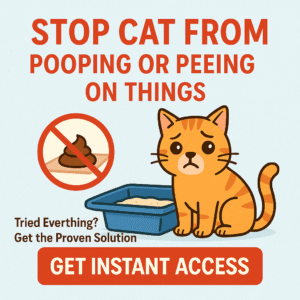Cat litter dust is one of the most frustrating parts of owning a cat. The fine cloud that coats your floor, paws, and sometimes even your lungs can make daily life feel messy. In this guide, you’ll learn why litter dust happens, how it affects both you and your cat, and practical ways to reduce or eliminate it—while keeping your cat’s litter box fresh and comfortable.
Plus, discover how consistency and routine—like the kind emphasized in the Cat Spray No More ebook—will help you maintain cleaner air, happier paws, and a healthier home environment.
Why Is Cat Litter Dusty?
Most traditional clay or clumping litters generate dust for several reasons:
- Fine granules: Clay particles pulverize into powder with use.
- Inadequate processing: Low-quality litters aren’t screened or washed thoroughly.
- Pouring action: Pouring litter generates airborne dust clouds.
- Box activity: Scratching, digging, and kicking release dust.
The Impact of Dust on Health & Hygiene
For Your Cat
- Inhaled dust can irritate respiratory systems.
- Clumping litter dust can irritate paw pads or skin.
- If tracked outdoors, it can irritate delicate paw areas.
For You and Household
- Breathing litter dust daily may irritate lungs or aggravate allergies.
- Dust settles on countertops, bedding, and furniture—creating chore fatigue.
- Fine particles can get into electronics, reducing performance.
Top 6 Ways to Reduce Cat Litter Dust
1. Switch to Low-Dust or Dust-Free Litter
Check labels for “99% dust-free” or “reduced-dust” claims. Types like corn, wheat, paper, walnut, and silica are naturally lower in dust than clay. These alternatives often work just as well in odor control and clumping:
- Silica crystal litter: Very low dust and high absorption—ideal for cats and owners with allergies.
- Plant-based litters: Made from corn, wheat, pine, or walnut shells—eco-friendly and low-dust.
2. Pre-Rinse Clay Litter
For budget-friendly clay litters, pre-rinse helps remove loose dust:
- Put litter in a large bucket or mesh bag.
- Rinse gently with water—no vigorous agitation.
- Drain thoroughly and let it dry fully (takes 24–48 hours).
- Pour into the litter box; expect lower dust levels and less tracking.
3. Add a Dust Barrier Layer
After pouring fresh litter, add a thin layer of baking soda or wheat bran on top. It helps trap dust as your cat digs and clumps form. You can skim it off when you scoop to renew freshness.
4. Use a Litter Box Mat and Entry Shield
Place a durable mat under and around the litter box to catch dust and scattering granules. This reduces airborne particles and keeps the floor clean. For open-style boxes, consider adding a removable rim extender to reduce kicks and spread.
5. Scoop Gently and Clean Regularly
- Use a low-dust scoop—solid design with bigger slots helps filter the dust.
- Scoop daily to reduce tracking and buildup.
- Deep clean the box weekly using unscented soap and gentle rinsing.
6. Keep the Area Well-Ventilated
Install a small air purifier with a HEPA filter near the litter box. Just a modest model running on low effectively traps dust and helps maintain clean air. Alternatively, open a nearby window during cleaning to reduce dust buildup.
Alternative Litter Types Compared
| Type | Dust Level | Tracking | Odor Control | Eco-Friendliness |
|---|---|---|---|---|
| Clay Clumping | High | Medium | Good | Low |
| Silica Crystal | Very Low | Low | Excellent | Medium |
| Corn/Wheat | Low | Medium | Good | High |
| Paper/Recycle | Very Low | Low | Variable | High |
| Walnut Shells | Low | Low–Medium | Good | High |
Real-World Tips from Experienced Cat Owners
- “I poured fresh clay litter from a height—dust cloud! Now I rinse and pour low to reduce it massively.”
- “Using a reusable microfiber mat captures all particles—I shake it out weekly and my floors stay clean.”
- “My air purifier is a game-changer—it removes dust I didn’t even know was there.”
When to Consider Switching Litters Completely
- If household members have asthma, allergies, or respiratory sensitivities.
- If you’ve tried other methods and still see dust clouds when your cat digs.
- When your maintenance routine doesn’t eliminate dust, a low-dust formula is the long-term answer.
Why Routines Matter—Inspired by Cat Spray No More
The same strategies that help stop cat spray accidents—like daily maintenance, calm environment, and regular routines—apply directly to minimizing dust:
- Consistency: Daily scooping, weekly deep-cleaning, and regular litter refills create a stable environment.
- Clean habits: Enzyme cleaning for accidents is similar to dust-proofing boxes.
- Health awareness: Checking your cat’s litter behavior keeps you attentive to breathing or paw issues early.
DIY Dust-Reduction Checklist
- Choose a dust-reducing litter type.
- Pre-rinse if using budget clay litter.
- Use a barrier layer after scooping and refilling.
- Install mats and entry shields around boxes.
- Scoop gently using proper techniques.
- Deep clean boxes weekly.
- Ventilate the area or use a HEPA air purifier.
- Monitor dust levels and adjust routines as needed.
When You’ve Achieved a Low-Dust Zone
- Minimal visible particles around the box.
- No dust clouds when cats kick or dig.
- Healthier lung and breathing conditions for humans and cats.
- Less frequent housekeeping and less wear on electronics.
Wrapping Up & Final Thought
Litter dust doesn’t need to be a messy sacrifice for cat care. With targeted approaches like switching litters, rinsing, adding barrier layers, and improving ventilation, you can dramatically reduce dust—without losing clumping, odor control, or your cat’s comfort.
The Cat Spray No More ebook emphasizes routine, environment, and habit-building—tools that translate perfectly to maintaining a low-dust, healthy cat zone. If you’re ready to upgrade your litter strategy and your cat-care habits overall, this guide is a terrific companion.
Download Cat Spray No More now, apply its routines to your litter setup, and enjoy a cleaner, calmer home today.
